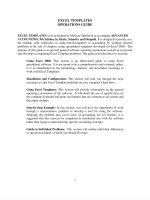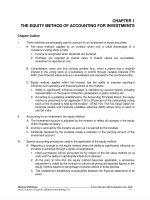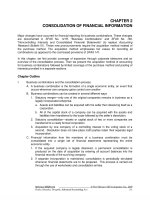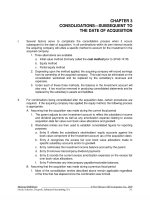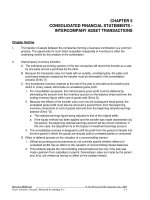Solution manual advanced accounting 2nd by hamlen CH06
Bạn đang xem bản rút gọn của tài liệu. Xem và tải ngay bản đầy đủ của tài liệu tại đây (947.51 KB, 30 trang )
Find more at www.downloadslide.com
CHAPTER 6
SOLUTIONS TO MULTIPLE CHOICE QUESTIONS, EXERCISES AND PROBLEMS
MULTIPLE CHOICE QUESTIONS
1.
c
Only the expenses related to provision of services are transactions with outside parties.
The $3,000,000 revenue reported by Suzlon and the $3,000,000 expense reported by
Patni are eliminated.
2.
d
Eliminating entries remove the intercompany asset (loan receivable) and liability (loan
payable) and the interest revenue and interest expense. There is no effect on timing of
income recognition, and therefore no adjustment is made to the investment account or
beginning retained earnings.
3.
a
Downstream sales only affect equity in net income. The effect is [($540,000 - $480,000)
- ($540,000 - $480,000)/1.2] = increase of $10,000.
4.
d
Only the adjustment to 2013 depreciation affects equity in net income and noncontrolling
interest in net income. It is an upstream sale, so the increase of $2,000,000/10 =
$200,000 is shared 80% - 20%.
5.
b
From the consolidated company’s perspective, it paid $35,000 for the land and sold it for
$85,000. Therefore the consolidated gain is $50,000.
6.
a
The intercompany gain, recognized by the subsidiary in 2010, is $400,000. In 2013, the
parent sells the land to an outside party for $550,000, reporting a loss of $850,000 (=
$1,400,000 - $550,000). The consolidated loss is $450,000 (= $1,000,000 - $550,000).
The 2013 eliminating entry adjusts the reported $850,000 loss to $450,000, and
reclassifies it from the subsidiary’s beginning retained earnings.
Solutions Manual, Chapter 6
©Cambridge Business Publishers, 2013
1
Find more at www.downloadslide.com
7.
a
The consolidation working paper for 2013 is:
Parent
Subsidiary
Dr
Inventory
$100,000
-Sales
450,000
500,000 (I-1) 500,000
CGS
400,000
400,000 (I-2) 20,000
8.
Cr
Consolidated
20,000 (I-2)
$80,000
450,000
500,000 (I-1)
320,000
d
Eliminating entries are:
Sales
30,000,000
CGS
Investment in subsidiary
30,000,000
200,000
CGS
CGS
200,000
225,000
Inventory
9.
225,000
b
Eliminating entries are:
Patent
600,000
Investment in subsidiary
600,000
Unconfirmed downstream loss at the beginning of 2013 is [($1,000,000/5) x 3)] =
$600,000.
Amortization expense
200,000
Patent
To correct the amortization expense for 2013.
10.
200,000
c
Eliminating entries are:
Retained earnings, subsidiary
1,700,000
Equipment, net
1,700,000
Unconfirmed upstream gain at the beginning of 2012 is [($2,000,000/20) x 17)] =
$1,700,000.
Equipment, net
Depreciation expense
To correct the depreciation expense for 2013.
©Cambridge Business Publishers, 2013
2
100,000
100,000
Advanced Accounting, 2nd Edition
Find more at www.downloadslide.com
EXERCISES
E6.1
Intercompany Land Transactions
a.
Consolidation Working Paper
2012
Gain on sale of land
150,000
Land
150,000
To eliminate the unconfirmed gain on the intercompany sale of land and reduce the land
account to original acquisition cost.
2013
Investment in Sunnyvale
150,000
Land
150,000
To add the prior year unconfirmed gain to the investment account to maintain
equivalence with the retained earnings of Sunnyvale and reduce the land account to
original acquisition cost.
b.
2014
Investment in Sunnyvale
150,000
Gain on sale of land
150,000
To include the prior year intercompany gain, now confirmed, in current year income and
restate the investment account by offsetting the previous reduction while the gain was
unconfirmed.
E6.2
Intercompany Land Transactions
1.
In a prior year, the subsidiary sold land to the parent at a gain of $20,000. The parent still
holds the land.
Current year intercompany sale of land at a loss of $14,000.
In prior year, the parent sold land to its subsidiary at a gain of $30,000. The subsidiary
still holds the land.
In a prior year, the subsidiary sold land to the parent at a gain of $18,000. The parent
sold the land to an outside party this year.
2.
3.
4.
Solutions Manual, Chapter 6
©Cambridge Business Publishers, 2013
3
Find more at www.downloadslide.com
E6.3
Intercompany Merchandise Transactions
(in thousands)
Consolidation Working Paper
Retained earnings, Converse -1/1
15,000
Investment in Converse
27,000
Cost of goods sold
42,000
To eliminate the intercompany profit on upstream intercompany sales, assumed confirmed
during 2013, from the beginning inventory. Prior year profits on upstream sales are removed
from Converse’s beginning retained earnings; $15,000 = $75,000 x 20%. Prior year profits on
downstream sales are added to Nike’s Investment in Converse as they had been removed from
the Investment account via the 2013 equity accrual; $27,000 = $117,000 - 117,000/1.3.
Sales
1,150,000
Cost of goods sold
To eliminate intercompany merchandise sales made during 2013.
1,150,000
Cost of goods sold
41,500
Inventory
41,500
To eliminate unconfirmed intercompany profit from ending inventory; $41,500 = ($80,000 x
20% = $16,000) + [110,500 - (110,500/1.3) = $25,500].
E6.4
Analysis of Land Sale Alternatives
Under a direct sale of the land by Sawyer to the developer, Sawyer reports a gain of $3,900,000.
The noncontrolling interest in net income is $780,000 (= .2 x $3,900,000) and the distribution to
the noncontrolling shareholder is $390,000 (= .5 x $780,000).
Under the intercompany sale, even though the gain is larger, it is eliminated in consolidation, and
does not enter into the noncontrolling interest in net income. As long as the parent holds the land
(which it plans to do under a long-term lease), the gain is not reflected in noncontrolling interest
in net income. Moreover, the income from the lease is the parent’s income, so the
noncontrolling interest is unaffected. Under this approach, the noncontrolling stockholder
receives nothing.
Hence, the direct sale of the land by Sawyer to the developer generates the most dividends for
the noncontrolling stockholder.
©Cambridge Business Publishers, 2013
4
Advanced Accounting, 2nd Edition
Find more at www.downloadslide.com
E6.5
Intercompany Equipment Transactions
a.
2013 Consolidation Working Paper
Gain on sale of equipment
250,000
Equipment
250,000
To eliminate the gain on intercompany sale of equipment; $250,000 = $800,000 –
($750,000 - $200,000).
Accumulated depreciation
50,000
Depreciation expense
To eliminate the excess depreciation recorded by Sawyer in 2013 ($250,000/5).
Equipment
50,000
200,000
Accumulated depreciation
200,000
To restate the equipment and accumulated depreciation accounts to their original
acquisition cost basis.
b.
2014 Consolidation Working Paper
Investment in Sawyer
Accumulated depreciation
200,000
50,000
Equipment
250,000
To eliminate the amount of intercompany gain unconfirmed in prior years, remove the
excess depreciation recorded in prior years and reduce the equipment to its net book
value at date of intercompany sale.
Accumulated depreciation
50,000
Depreciation expense
To eliminate the excess depreciation recorded by Sawyer in 2014.
Equipment
50,000
200,000
Accumulated depreciation
200,000
To restate the equipment and accumulated depreciation accounts to their original
acquisition cost basis.
Solutions Manual, Chapter 6
©Cambridge Business Publishers, 2013
5
Find more at www.downloadslide.com
E6.6
a.
Various Intercompany Transactions
Consolidation Working Paper
(Upstream)
Retained earnings – Sand Hill
Land
2,500,000
2,500,000
Retained Earnings – Sand Hill
1,400,000
Cost of goods sold
1,400,000
Cost of goods sold
3,200,000
Inventory
3,200,000
Retained earnings – Sand Hill
Accumulated depreciation
800,000
400,000
Equipment
1,200,000
Accumulated depreciation
200,000
Depreciation expense
200,000
Equipment
2,000,000
Accumulated depreciation
b.
2,000,000
Consolidation Working Paper
(Downstream)
Investment in Sand Hill
2,500,000
Land
Investment in Sand Hill
2,500,000
1,400,000
Cost of goods sold
Cost of goods sold
1,400,000
3,200,000
Inventory
Investment in Sand Hill
Accumulated depreciation
3,200,000
800,000
400,000
Equipment
Accumulated depreciation
1,200,000
200,000
Depreciation expense
Equipment
2,000,000
Accumulated depreciation
©Cambridge Business Publishers, 2013
6
200,000
2,000,000
Advanced Accounting, 2nd Edition
Find more at www.downloadslide.com
E6.7
Intercompany Transactions, Equity Method Income and Noncontrolling Interest
a.
Total
Swaraj reported net income
$7,000,000
Amortization of identifiable intangibles
(1,750,000)
Upstream loss on land
300,000
Unconfirmed profit in end. inventory - upstream
(600,000)
Confirmed profit in beg. inventory - upstream
350,000
Confirmed profit on downstream equipment
sale
100,000
(= $1,000,000/10)
$5,400,000
b.
Equity
Noncontrolling
in NI
Interest in NI
$5,600,000
$1,400,000
(1,400,000)
(350,000)
240,000
60,000
(480,000)
(120,000)
280,000
70,000
100,000
$4,340,000
_______
$1,060,000
Consolidation Working Paper
Land
300,000
Loss on sale of land
To eliminate the unconfirmed loss on upstream land sale.
Cost of goods sold
300,000
600,000
Inventory
To eliminate the unconfirmed profit in ending inventory due to upstream sales.
Retained earnings—Swaraj, beg.
350,000
Cost of goods sold
To recognize the confirmed profit in beginning inventory due to upstream sales
Investment in Swaraj
Accumulated depreciation
600,000
350,000
700,000
300,000
Equipment
1,000,000
To eliminate the unconfirmed profit as of the beginning of the year on downstream
equipment sales (=7/10 x $1,000,000).
Accumulated depreciation
100,000
Depreciation expense
To eliminate intercompany profit from depreciation expense (= $1,000,000/10).
Solutions Manual, Chapter 6
100,000
©Cambridge Business Publishers, 2013
7
Find more at www.downloadslide.com
E6.8
Item
1.
2.
3.
4.
E6.9
Income Effects of Unconfirmed Intercompany Profits
Decrease in consolidated net
Decrease in noncontrolling
income to the controlling interest
interest in net income
$ 200,000
-240,000
$ 60,000
800,000
-520,000
130,000
$1,760,000
$190,000
Consolidated Income Statement—Intercompany Transactions
(in thousands)
a.
Total
SCO’s reported net income
Amortization of identifiable intangibles
Unconfirmed profit in end. inv. - downstream
Unconfirmed profit in end. inv. - upstream
b.
Equity
in NI
$200,000 $ 150,000
(36,000)
(27,000)
(50,000)
(50,000)
(40,000)
(30,000)
$ 74,000 $ 43,000
PCO and SCO
Consolidated Income Statement
Sales ($2,000,000 + $1,200,000 - $400,000)
Cost of goods sold ($1,000,000+$700,000-$400,000+$50,000+$40,000)
Other expenses ($600,000 + $300,000 + $36,000)
Consolidated net income
Noncontrolling interest in net income
Consolidated net income to controlling interest
©Cambridge Business Publishers, 2013
8
Noncontrolling
Interest in NI
$ 50,000
(9,000)
(10,000)
$ 31,000
$2,800,000
(1,390,000)
(936,000)
$ 474,000
(31,000)
$ 443,000
Advanced Accounting, 2nd Edition
Find more at www.downloadslide.com
E6.10 Consolidated Income Statement, Intercompany Transactions
a.
Star’s reported net income
Amortization of identifiable intangibles
Goodwill impairment loss
Confirmed profit in beg. inv. - upstream
Unconfirmed profit in end. inv. - downstream
b.
Total
$ 900,000
(100,000)
(200,000)
110,000
(60,000)
$ 650,000
Equity
Noncontrolling
in NI
Interest in NI
$ 720,000
$ 180,000
(80,000)
(20,000)
(160,000)
(40,000)
88,000
22,000
(60,000)
-$ 508,000
$ 142,000
Pon and Star
Consolidated Income Statement
Sales ($9,000,000 + $4,000,000 – $1,000,000)
Cost of goods sold ($6,000,000+$2,500,000–$1,000,000–
$110,000+$60,000)
Other expenses ($2,000,000 + $600,000 + $100,000 + $200,000)
Consolidated net income
Less consolidated net income attributed to noncontrolling interest
Consolidated net income attributed to controlling interest
$ 12,000,000
( 7,450,000)
( 2,900,000)
1,650,000
( 142,000)
$ 1,508,000
E6.11 Ratio Analysis of Enron-Type Intercompany Transactions
(all dollar amounts in millions)
a.
1.
ROA = ($9,000 - $8,000 + $500)/($10,000 + $500) = $1,500/$10,500 = .143
ROS = $1,500/($9,000 + $3,000) = $1,500/$12,000 = .125
2.
ROA = ($9,000+$2,000-$8,000-$1,900)/($10,000+$4,000)
= $1,100/$14,000 = .079
ROS = $1,100/($9,000 +$2,000) = .10
Consolidation (2) eliminates the intercompany revenue and the unconfirmed
intercompany gain, voiding the internal transaction for financial reporting purposes.
Ratios look better when the transaction with the SPE is considered to be arm’s length and
consolidation is avoided (1).
Solutions Manual, Chapter 6
©Cambridge Business Publishers, 2013
9
Find more at www.downloadslide.com
b.
1.
TL/TA = $6,000/($10,000 + $3,500) = $6,000/$13,500 = .444
2.
TL/TA = ($6,000 + $3,600 + $3,500)/($10,000 + $4,000 + $3,500)
= $13,100/$17,500 = .749
Without consolidation (1) Sponsor recognizes the $3,500 cash but not the liability, but in
consolidation (2) the liability is also counted along with Sponsoree’s assets and liabilities.
Sponsoree is more leveraged than Sponsor; Sponsoree’s separate TL/TA = $3,600/$4.000
= .9, while Sponsor’s separate TL/TA = $6,000/$10,000 = .6. Therefore consolidating
Sponsoree causes consolidated TL/TA to be higher than Sponsor’s separate TL/TA.
c.
1.
ROA = [$9,000 - $8,000 + .25 ($4,300 - $3,500)]/($10,000 + $3,500)
= $1,200/$13,500 = .089
2.
ROA = ($9,000 + $2,000 – $8,000 – $1,900)/($10,000 + $4,000 + $3,500)
= $1,100/$17,500 = .063
Enron apparently used this technique to recognize gains on its own stock as income,
something not permitted by GAAP. Without consolidation (1), Sponsor’s income
includes 25% of the ―gain‖ on its stock recognized in Sponsoree’s income and booked by
Sponsor via the equity method. With consolidation (2) the ―stock issuance‖ is voided and
neither entity recognizes income on the appreciation of Sponsor’s stock.
E6.12 Comprehensive Consolidated Net Income
Schedule to determine consolidated net income (in thousands)
Brown’s net income from its own operations
Shoes.com’s net income from its own operations
Decrease in cost of goods sold from sale of overvalued inventory
Depreciation expense reduction from overvaluation adjustment
Increase in fair value of contingent consideration liability
Amortization of discount on long-term debt (increase in interest expense)
Impairment loss on capitalized in-process R&D
Increase in cost of goods sold due to eliminated upstream ending
inventory profit
Eliminated loss on downstream sale of patent
Increase in patent amortization expense on the patent ($500/5)
Consolidated net income
Less consolidated net income attributed to noncontrolling interest*
Consolidated net income attributed to controlling interest
$ 50,000
20,000
900
300
(200)
(100)
(600)
(400)
500
(100)
70,300
(2,010)
$ 68,290
* $2,010 = .1 x ($20,000 + $900 + $300 – $100 – $600 – $400)
©Cambridge Business Publishers, 2013
10
Advanced Accounting, 2nd Edition
Find more at www.downloadslide.com
PROBLEMS
P6.1
Consolidation Working Paper, Noncontrolling Interest, Intercompany
Inventory Transactions
a.
Calculation of goodwill:
Acquisition cost
Fair value of noncontrolling interest
Total fair value
Book value of Seaport
Previously unrecorded intangibles
Goodwill
$ 3,000,000
275,000
3,275,000
$ 2,000,000
__500,000
Allocation of goodwill between controlling and noncontrolling interests:
Total goodwill
Peninsula’s goodwill: $3,000,000 – 90%($2,500,000)
Goodwill to noncontrolling interest
Proportions: $750/$775 to controlling interest and $25/$775 to the
noncontrolling interest
b.
2,500,000
$ 775,000
$
$
775,000
750,000
25,000
Calculation of 2013 Equity in Net Income and Noncontrolling Interest in Net Income (in
thousands):
Equity in
Noncontrolling
Total
NI
interest in NI
Seaport Company reported net income
($6,000,000 – 3,170,000 – 1,930,000)
$ 900,000
$ 810,000
$ 90,000
Upstream markup, beginning inventory
100,000
90,000
10,000
Downstream markup, beg. inventory
60,000
60,000
Upstream markup, ending inventory
(80,000)
(72,000)
(8,000)
Downstream markup, ending inventory
(75,000)
(75,000)
______
$ 905,000
$ 813,000
$ 92,000
Solutions Manual, Chapter 6
©Cambridge Business Publishers, 2013
11
Find more at www.downloadslide.com
c.
Consolidation Working Paper, December 31, 2013 (in millions)
Trial Balances
Eliminations
Taken From Books
Dr (Cr)
Consolidated
Peninsula Seaport
Current assets
Investment in Seaport
Property, plant and equipment, net
Intangibles
Goodwill
Liabilities
Capital stock
Retained earnings, Jan. 1
$ 1,950
4,183
$
980
--
5,810
4,270
5,120
--
(4,900)
(3,000)
(6,700)
(2,100)
(1,200)
(2,300)
Dr
(I-2)
60
Sales
Equity in net income of Seaport
Cost of goods sold
Operating expenses
Noncontrolling interest in net income
©Cambridge Business Publishers, 2013
12
1,000
(15,000)
(813)
9,050
4,150
______
$
0
340
45
52
360
40
3,170
1,930
_____
$
0
(I-1)5,900
(C) 813
(I-3) 155
$ 2,775
--
10,930
4,570
475
(7,000)
(3,000)
(6,700)
(E) 1,200
(I-2) 100
(E) 2,200
400
(6,000)
155 (I-3)
453 (C)
3,060 (E)
730 (R)
(R) 300
(R) 475
Noncontrolling interest
Dividends
Balances
Cr
(E)
(R)
(N)
(C)
(N)
160 (I-2)
5,900 (I-1)
(N) 92 ______
$ 11,295 $ 11,295
(437)
1,000
(15,100)
-6,315
6,080
92
$
0
Advanced Accounting, 2nd Edition
Find more at www.downloadslide.com
P6.2
Consolidation Working Paper, Noncontrolling Interest, Intercompany
Merchandise Transactions
(in thousands)
a.
Calculation of goodwill:
Acquisition cost
Fair value of noncontrolling interest
Total fair value
Book value of Wholesome
Revaluations:
Plant and equipment, net
Intangibles
Long-term debt
Goodwill
$ 120,000
35,000
$ 155,000
$ 74,000
(15,000)
25,000
(4,000)
Allocation of goodwill between controlling and noncontrolling interest:
Total goodwill
Kellogg’s goodwill: $120,000 – 75%($80,000)
Goodwill to noncontrolling interest
Proportions: $60,000/$75,000 = 80% to controlling interest and 20%
to the noncontrolling interest
80,000
$ 75,000
$ 75,000
60,000
$ 15,000
b.
Wholesome’s reported net income for 2013
Revaluation write-offs for 2013:
Plant & equipment ($15,000/10)
Intangibles ($25,000/10)
Goodwill (80/20 split)
Intercompany sales adjustments:
Upstream beg. inventory profit confirmed
Upstream end. inventory profit
unconfirmed
Total
Total
$ 5,000
Equity in Noncontrolling
net income interest in net
of
income of
Wholesome
Wholesome
$ 3,750
$ 1,250
1,500
(2,500)
(1,000)
1,125
(1,875)
(800)
375
(625)
(200)
2,400
1,800
600
(3,000)
$ 2,400
(2,250)
$ 1,750
$
(750)
650
Note: The long-term debt premium is completely amortized by 2013.
Solutions Manual, Chapter 6
©Cambridge Business Publishers, 2013
13
Find more at www.downloadslide.com
c.
Consolidation Working Paper, December 31, 2013
Trial Balances Taken
From Books
Dr (Cr)
Eliminations
Consolidated
Kellogg’s
Current assets
Plant and equipment, net
Investment in Wholesome
$ 35,000
262,650
131,100
Identifiable intangibles
Goodwill
Current liabilities
Long-term debt
Capital stock
Retained earnings, Jan. 1
100,000
-(30,000)
(350,000)
(80,000)
(60,000)
Noncontrolling interest
Sales revenue
Equity in NI of Wholesome
Cost of goods sold
Operating expenses
Noncontrolling interest in NI
--
(400,000)
(1,750)
250,000
143,000
_____-$
0
©Cambridge Business Publishers, 2013
14
Wholesome
$
20,000
192,000
--
10,000
-(25,000)
(100,000)
(54,000)
(38,000)
Dr
(O)
Cr
1,500
(R) 12,500
(R) 73,000
(E) 54,000
(I-2) 2,400
(E) 35,600
--
(140,000)
-65,000
70,000
_____-$
0
3,000 (I-3)
7,500 (R)
1,750 (C)
67,200 (E)
62,150 (R)
2,500 (O)
1,000 (O)
$
52,000
448,650
-120,000
72,000
(55,000)
(450,000)
(80,000)
(60,000)
22,400 (E)
15,850 (R)
650 (N)
(I-1) 60,000
(C) 1,750
(I-3) 3,000
Balances
2,400 (I-2)
60,000 (I-1)
(O) 2,000
(N) 650 _______
$ 246,400 $246,400
(38,900)
(480,000)
-255,600
215,000
650
$
0
Advanced Accounting, 2nd Edition
Find more at www.downloadslide.com
P6.3
Intercompany Transfers of Depreciable Assets
a.
Consolidation Working Paper
Transaction (1)
Investment in Smart (2.5 x ($80,000/8))
25,000
Accumulated depreciation (5.5 x
$80,000/8))
55,000
Plant assets
80,000
To eliminate the intercompany gain unconfirmed in prior years, remove the excess
depreciation recorded in prior years and reduce the asset account to its net book value at
date of intercompany sale.
Accumulated depreciation
10,000
Depreciation expense
To eliminate the excess annual depreciation expense recorded by Smart in 2012.
10,000
Plant assets
20,000
Accumulated depreciation
20,000
To restate the asset and accumulated depreciation accounts to their original acquisition
cost basis.
Transaction (2)
Retained earnings-Smart
(6 x ($50,000/10))
Accumulated depreciation (4 x
($50,000/10))
30,000
20,000
Plant assets
50,000
To eliminate the intercompany gain unconfirmed in prior years, remove the excess
depreciation recorded in prior years and reduce the asset account to its net book value at
date of intercompany sale.
Accumulated depreciation
5,000
Depreciation expense
To eliminate the excess depreciation recorded by Pert in 2012.
Plant assets
5,000
300,000
Accumulated depreciation
300,000
To restate the asset and accumulated depreciation accounts to their original acquisition
cost basis.
Solutions Manual, Chapter 6
©Cambridge Business Publishers, 2013
15
Find more at www.downloadslide.com
Transaction (3)
Plant assets
40,000
Investment in Smart
(4 x $40,000/5))
32,000
Accumulated depreciation
($40,000/5)
8,000
To eliminate the intercompany loss unconfirmed in prior years, add back the reduced
depreciation recorded in prior years and increase the asset account to its book value at
date of intercompany sale.
Depreciation expense
8,000
Accumulated depreciation
8,000
To add back the reduced depreciation recorded by the purchasing affiliate (Smart) in
2012.
Plant assets
360,000
Accumulated depreciation
360,000
To restate the asset and accumulated depreciation accounts to their original acquisition
cost basis.
b.
Consolidation Working Paper
Retained earnings-Smart
30,000
Gain on sale of plant assets
30,000
To include in current year income the portion of the original intercompany gain of
$50,000 which had not been confirmed through depreciation as of the beginning of the
year. This remaining portion, which would have reduced depreciation over the next six
years (including 2012), has now been fully confirmed by an external sale in 2012.
NOTE: If there is a noncontrolling interest in Smart, it shares in this $30,000 gain but not
in the gain of $280,000 recorded by Pert on the external sale; $280,000 = $400,000 –
[$200,000 – 4 x ($200,000/10)].
©Cambridge Business Publishers, 2013
16
Advanced Accounting, 2nd Edition
Find more at www.downloadslide.com
P6.4
Consolidated Income Statement—Intercompany Transactions
a.
Sow's reported net income
Plus intercompany profit in Pow's beginning
inventory, now assumed confirmed
Less unconfirmed intercompany profit in
Sow's ending inventory
Plus Sow's unconfirmed loss on an
intercompany sale of land
Less Pow's unconfirmed gain on
intercompany sale of machinery at beginning
of year [$250,000 - $250,000/5)]
Plus Pow's gain on prior year intercompany
sale of land, confirmed through external sale
Net equity method income accrual
b.
Total
$ 800,000
Equity in Noncontrolling
net
interest in net
income
income
$ 760,000
$ 40,000
400,000
380,000
(200,000)
(200,000)
100,000
95,000
(200,000)
(200,000)
60,000
$ 960,000
60,000
$ 895,000
20,000
5,000
______
$ 65,000
Pow Company and Sow Company
Consolidated Statement of Income and Retained Earnings
Sales
$ 32,000,000 (1)
Other income
1,510,000 (2)
Total revenue
33,510,000
Cost of goods sold
23,400,000 (3)
Operating expenses
5,850,000 (4)
Other expenses
1,000,000 (5)
Total expenses
30,250,000
Consolidated net income
3,260,000
Noncontrolling interest in net income
65,000
Consolidated net income to parent
3,195,000
Consolidated retained earnings, January 1
15,700,000
Dividends
(1,000,000)
Consolidated retained earnings, December 31
$ 17,895,000
(1) $32,000,000 = $25,000,000 + $10,000,000 - $3,000,000 (intercompany sales).
(2) $1,510,000 = $1,200,000 + $500,000 - $250,000 (unconfirmed gain on machinery)
+ $60,000 (prior period gain on land now confirmed).
(3) $23,400,000 = $19,000,000 + $7,600,000 - $3,000,000 (intercompany purchases) $400,000 (intercompany profit in beginning inventory assumed confirmed) +
$200,000 (unconfirmed intercompany profit in ending inventory)
(4) $5,850,000 = $4,100,000 + $1,800,000 - $50,000 (excess depreciation)
(5) $1,000,000 = $800,000 + $300,000 - $100,000 (unconfirmed loss on land)
Solutions Manual, Chapter 6
©Cambridge Business Publishers, 2013
17
Find more at www.downloadslide.com
P6.5
Equity Accrual and Eliminating Entries—Intercompany Asset Transfers and
Services
(in thousands)
a.
Suro’s net income
Plus intercompany profits in Suro’s beginning
inventory (downstream sales); ($50,000 $50,000/1.25)
Less intercompany profits in Pohang’s ending
inventory (upstream sales); ($80,000 $80,000/1.25)
Less unconfirmed gain on upstream
intercompany sale of machinery; [$25,000 ($25,000/5)]
b.
Total
$ 200,000
Equity in
net income
$ 160,000
Noncontrolling
interest in net
income
$ 40,000
10,000
10,000
(16,000)
(12,800)
(3,200)
(20,000)
$ 174,000
(16,000)
$ 141,200
(4,000)
$ 32,800
Consolidation Working Paper
(C)
Income from Suro
141,200
Dividends - Suro
(.8 x .4 x $200,000)
Investment in Suro
To eliminate the current year equity method entries made by Pohang.
(I-1)
Stockholders’ equity (RE), 1/1 Suro
64,000
77,200
15,000
Land
15,000
To eliminate the unconfirmed gain from the prior year upstream transfer of land and
reduce the land account to original acquisition cost.
(I-2)
Sales
350,000
Cost of goods sold
To eliminate intercompany merchandise sales.
(I-3)
Investment in Suro
350,000
10,000
Cost of goods sold
10,000
To eliminate unconfirmed intercompany profit on downstream sales from beginning
inventory.
©Cambridge Business Publishers, 2013
18
Advanced Accounting, 2nd Edition
Find more at www.downloadslide.com
(I-4)
Cost of goods sold
16,000
Inventory
16,000
To eliminate unconfirmed intercompany profit on upstream sales from ending inventory.
(I-5)
Gain on sale of machinery
25,000
Machinery
To eliminate the gain on the intercompany sale of machinery.
25,000
(I-6)
Accumulated depreciation
5,000
Depreciation expense
5,000
To eliminate excess depreciation on the machinery acquired from Suro; this is the portion
of the $25,000 gain confirmed to Singular in 2012.
(I-7)
Machinery
40,000
Accumulated depreciation
To restate the machinery and accumulated depreciation accounts to their original
acquisition cost basis.
(I-8)
Computer service revenue
20,000
Computer service expense
To eliminate intercompany revenue and expense.
(I-9)
Accounts payable
20,000
3,000
Accounts receivable
To eliminate intercompany receivables and payables.
(E)
Stockholders’ equity – Suro (1)
40,000
3,000
1,575,000
Investment in
Singular
1,260,000
Noncontrolling
interest in Suro
315,000
To eliminate the remaining beginning stockholders= equity of Suro against the
investment and establish the book value of noncontrolling interest as of 1/1/12.
(1)
$1,575,000 = $1,500,000 + $150,000 - .4 x $150,000 - $15,000, where $1,500,000
= $1,250,000 + $300,000 – $50,000 Goodwill = Stockholders’ equity—Suro at
1/2/11.
Solutions Manual, Chapter 6
©Cambridge Business Publishers, 2013
19
Find more at www.downloadslide.com
(R)
Goodwill
50,000
Investment in Suro
To establish goodwill as of the beginning of the year.
50,000
Note: Goodwill is attributed only to the controlling interest:
Acquisition cost
$ 1,250,000
Fair value of noncontrolling interest
300,000
Total fair value
1,550,000
Book value of Suro, 1/2/11
1,500,000
Goodwill
$
50,000
Goodwill attributed to the controlling interest = $1,250,000 – 80% x $1,500,000 =
$50,000; no goodwill is attributed to the noncontrolling interest.
Note that the above entries eliminate the Investment in Suro balance of $1,377,200,
calculated as follows:
January 2, 2011 balance
Equity in income of Suro, 2011 (2)
Dividends, 2011
December 31, 2011 balance
Equity in income of Suro, 2012
Dividends, 2012
December 31, 2012 balance
(2)
$1,250,000
98,000
(48,000)
1,300,000
141,200
(64,000)
$1,377,200
Equity in net income for 2011 calculation:
80% x Suro’s book income of $150,000
unconfirmed upstream land profit (80%)
unconfirmed downstream profit in ending inventory (100%)
Equity in net income of Suro, 2011
(N)
Noncontrolling interest in net income
32,800
Dividends—Suro (.2 x .4
x $200,000)
Noncontrolling interest
in Suro
To record the change in the noncontrolling interest during 2012.
©Cambridge Business Publishers, 2013
20
$ 120,000
(12,000)
(10,000)
$ 98,000
16,000
16,800
Advanced Accounting, 2nd Edition
Find more at www.downloadslide.com
P6.6
Comprehensive Problem: Consolidation Working Paper and Financial
Statements
(in thousands)
a.
Calculation of goodwill:
Acquisition cost
Fair value of noncontrolling interest
Total fair value
Book value of Selene
Previously unrecorded intangibles
Goodwill
Consideration paid
75% x $14,000
Goodwill to parent
Goodwill to noncontrolling interest
b.
$ 20,100
5,900
26,000
$ 10,000
4,000
$ 20,100
10,500
$ 9,600
$ 2,400
14,000
$ 12,000
80%
20%
Calculation of 2014 Equity in Net Income and Noncontrolling Interest in Net Income (in
thousands):
Equity Noncontrolling
Total
in NI
interest in NI
Selene’s reported net income ($50,000 – 35,000 –
8,000)
$ 7,000 $ 5,250
$ 1,750
Amortization, developed tech ($4,000/5)
(800)
(600)
(200)
Confirmed downstream gain on equipment (excess
depreciation) ($2,000/10)
200
200
Upstream markup, beg. inv. ($1,800 – $1,800/1.2)
300
225
75
Upstream markup, end. inv. ($2,400 – $2,400/1.2)
(400)
(300)
(100)
Downstream markup, beg. inv. ($3,000 x 20%)
600
600
Downstream markup, end. inv. ($2,800 x 20%)
(560)
(560)
_____
$ 6,340 $ 4,815
$ 1,525
Solutions Manual, Chapter 6
©Cambridge Business Publishers, 2013
21
Find more at www.downloadslide.com
c.
Consolidation Working Paper, December 31, 2014 (in thousands)
Trial Balances
Eliminations
Taken From Books
Dr (Cr)
Consolidated
Cash
Receivables
Inventories
Plant and equipment, net
Investment in Selene
Intangibles
Goodwill
Current liabilities
Long-term debt
Capital stock
Retained earnings, January 1
Pierre
Selene
$ 1,000
5,600
70,000
460,000
25,040
$ 2,500
10,000
30,000
150,000
Dr
$
(I-2) 200
(I-1) 1,600
(I-4) 600
(R) 1,600
(R) 9,000
(4,000)
(2,800)
(489,825) (163,700)
(5,000)
(2,000)
(90,000) (20,000)
Sales revenue
Equity in income of Selene
Cost of sales
Operating expenses
Noncontrolling interest in net income
40,000
(150,000)
(4,815)
100,000
42,000
_____
$
-0-
960 (I-5)
1,600 (I-1)
2,565 (C)
16,275 (E)
8,400 (R)
800 (O)
(E) 2,000
(I-4) 300
(E) 19,700
Noncontrolling interest
Dividends
Balances
Cr
(50,000) (I-3) 35,000
(C) 4,815
35,000 (I-5) 960
-800
9,000
(6,800)
(653,525)
(5,000)
(90,000)
5,425
2,200
775
2,250
750
3,000
3,500
15,600
99,040
608,600
(E)
(R)
(N)
(C)
(N)
35,000 (I-3)
900 (I-4)
8,000 (O) 800
200 (I-2)
_____ (N) 1,525 _______
$
-0- $ 78,100 $ 78,100
(8,400)
40,000
(165,000)
-100,060
50,600
1,525
$
-0-
d.
Consolidated Statement of Income and Retained Earnings For the Year 2014
Sales
$ 165,000
Costs of goods sold
(100,060)
Gross margin
64,940
Operating expenses
(50,600)
Consolidated net income
14,340
Noncontrolling interest in income
(1,525)
Consolidated income to controlling interest
12,815
Retained earnings, January 1
90,000
Dividends
(40,000)
Retained earnings, December 31
$ 62,815
©Cambridge Business Publishers, 2013
22
Advanced Accounting, 2nd Edition
Find more at www.downloadslide.com
Consolidated Balance Sheet, December 31, 2014
Assets
Current assets:
Cash
Receivables
Inventories
Total current assets
Plant and equipment, net
Intangibles
Goodwill
Total assets
Liabilities and Stockholders’ Equity
Current liabilities
Long-term debt
Total liabilities
Stockholders’ equity
Capital stock
Retained earnings
Equity to Pierre
Noncontrolling interest
Total stockholders’ equity
Total liabilities and stockholders’ equity
P6.7
$
3,500
15,600
99,040
118,140
608,600
800
9,000
$ 736,540
$
6,800
653,525
660,325
5,000
62,815
67,815
8,400
76,215
$ 736,540
Calculation of Investment and Consolidated Accounts Several Years After
Acquisition
(in millions)
a.
Pentland’s retained earnings from its own operations
Equity in net income, 2011 – 2014:
75 % of Sketchers’ total net income since acquisition (75% x $140)
Less 75% of amortization on asset revaluation [75% x (($60/5) x 4)]
Less 80% of goodwill impairment loss (80% x $5) (Note 1)
Less 75% of unconfirmed gain on upstream land sale (75% x $30)
Less unconfirmed gain on downstream patent sale [$10 – (($10/10) x 3)]
Less 75% of unconfirmed profit on upstream ending inventory (75% x 20)
Less unconfirmed profit on downstream ending inventory
Equity in net income, 2011 – 2014
Consolidated retained earnings, December 31, 2014
Solutions Manual, Chapter 6
$
55
105
(36)
(4)
(22.5)
(7)
(15)
(17)
3.5
$ 58.5
©Cambridge Business Publishers, 2013
23
Find more at www.downloadslide.com
Note 1: Goodwill is shared in a 80:20 ratio, calculated as follows:
Acquisition cost
Fair value of noncontrolling interest
Total fair value
Book value
Revaluation of intangibles
$ 180
50
230
$ 20
60
Goodwill
80
$ 150
Goodwill to controlling interest [180 – (75% x 80)]
Goodwill share to controlling interest (120/150)
$ 120
80%
b.
Investment in Sketchers, January 2, 2011
Plus equity in net income, 2011 - 2014
Less 75% of Sketchers’ dividends, 2011 – 2014 (12 x 75%)
Investment in Sketchers, December 31, 2014
$ 180
3.5
(9)
$174.5
c.
Fair value of noncontrolling interest, January 2, 2011
Plus noncontrolling interest in net income, 2011 – 2014:
25 % of Sketchers’ total net income since acquisition (25% x $140)
Less 25% of amortization on asset revaluation [25% x (($60/5) x 4)]
Less 20% of goodwill impairment loss (20% x $5) (Note 1)
Less 25% of unconfirmed gain on upstream land sale (25% x $30)
Less 25% of unconfirmed profit on upstream ending inventory (25% x 20)
Noncontrolling interest in net income, 2011 – 2014
Less 25% of Sketchers’ dividends, 2011 – 2014 (12 x 25%)
Consolidated noncontrolling interest, December 31, 2014
©Cambridge Business Publishers, 2013
24
$
50
35
(12)
(1)
(7.5)
(5)
9.5
(3)
$ 56.5
Advanced Accounting, 2nd Edition
Find more at www.downloadslide.com
P6.8
Bonus Based on Adjusted Subsidiary Income
Net income before taxes
Adjustment for unconfirmed intercompany inventory profits:
Increase in inventory
Percent acquired from parent
Increase in intercompany inventory
Gross margin percentage
Increase in unconfirmed intercompany inventory profit
Plus interest paid to parent (= $600,000 x .10)
Revised income base
Less 40% for corporate costs and income taxes
Base for bonus
$150,000
$380,000
x .8
304,000
x .35
(106,400)
60,000
103,600
(41,440)
62,160
x .15
$ 9,324
Bonus
P6.9
Consolidated Income Statement—Intercompany Transactions
a.
Salem reported net income
Confirmed profit in BI-downstream
Unconfirmed profit in EI-upstream
Unconfirmed loss on asset sale-downstream
Confirmed loss on asset sale-downstream
= $360,000/6
Unconfirmed gain on land sale-upstream
Confirmed gain (excess amortization) on
patent sale-upstream = $250,000/5
Unconfirmed gain on prior year patent sale,
as of beg.of year-upstream = $250,000/5 x 2
Solutions Manual, Chapter 6
Total
$6,200,000
650,000
(500,000)
360,000
Equity in
NI
$4,960,000
650,000
(400,000)
360,000
Noncontrolling
Interest in NI
$1,240,000
(60,000)
(190,000)
(60,000)
(152,000)
(38,000)
50,000
40,000
10,000
100,000
$6,610,000
80,000
$5,478,000
20,000
$1,132,000
(100,000)
©Cambridge Business Publishers, 2013
25




